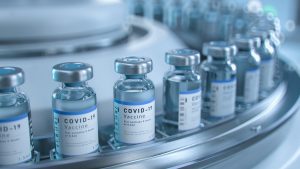The rollout of COVID-19 vaccinations has officially started in Australia.

The Australian government has developed a plan to have as many Australians as possible vaccinated by the end of 2021. The rollout plan outlines four phases to deliver the vaccines, ensuring those at greater risk of contracting the disease are closer to the top of the list.
The four phases are Phase 1a, Phase 1b, Phase 2a and Phase 2b.
Phase 1a has already started, with those regularly exposed to potential sources of COVID-19 currently being vaccinated.
This includes people who are:
- Quarantine and border workers
- Frontline health care workers
- Laboratory staff handling potentially infectious samples
- Aged care residents
- Staff working in aged care and disability services.
If you have a medical condition, you may be eligible for vaccination in the next phase (Phase 1b).
Who is in Phase 1b?
The second group of people to receive the vaccination are other health and high-risk workers (e.g. emergency services, police, meat processing workers).
It also includes people most at risk of poor outcomes if they contract COVID-19, such as:
- Adults aged 70 years and over
- Aboriginal and Torres Strait Islander people aged over 55 years
- Adults with an underlying health or medical condition or a disability.
Some hormone-related conditions are included in Phase 1b
The list of people eligible for vaccination in Phase 1b includes those with certain hormone-related health conditions, as well as people receiving certain treatments that can alter hormone levels and increase the risk of poor COVID-19 outcomes.

The Phase 1b list includes people with:
- Diabetes
- Severe Obesity
- Chronic kidney disease
- Heart disease
- Poorly controlled blood pressure
- Cancers diagnosed in the last 12 months
- Chronic inflammatory conditions
As well as people:
- Taking immune suppressive therapy (including glucocorticoid therapy)
- Having chemotherapy or radiotherapy
Endocrinologist A/Prof Diana Learoyd of the Council of the Endocrine Society of Australia, advises there are certain hormone conditions that are worthy of vaccination in Phase 1b.
“ESA regards patients with diabetes, hypopituitarism and adrenal insufficiency, including Addison’s disease, as worthy of vaccination in the phase 1b rollout”, explains Dr Learoyd. “These patients are at risk of more severe disease if they contract Covid-19”.
“ESA also advises that patients with any form of adrenal insufficiency, be it primary or secondary, should increase their usual steroid replacement, as they would usually do for sick day management if they experience any side-effects from the vaccine.”
It is important to discuss your condition or treatment with your GP or treating medical doctor. They can advise whether you should be vaccinated in Phase 1b, or whether it is safe to wait until a later date.
Who is in Phase 2a and 2b?
Phase 2a includes adults aged 50-69 years, Aboriginal and Torres Strait Islander people aged 18-54, and other critical and high-risk workers.
All other adults in the population will be eligible for a vaccine in Phase 2b. At this stage, the government expects this to occur in mid-2021.
Eligibility Checker
To help people understand into which phase they belong, the health department has created an online eligibility checker tool. This tool asks for your age, the state in which you live, your occupation, whether you identify as an Aboriginal and Torres Strait Islander, and whether you have underlying health conditions. The tool then calculates which phase you are in based on your circumstances, and when this is likely to occur.
This tool can be found here: https://covid-vaccine.healthdirect.gov.au/eligibility
More information about the COVID-19 vaccination rollout can be found on the Department of Health website here:
https://www.health.gov.au/initiatives-and-programs/covid-19-vaccines/getting-vaccinated-for-covid-19/when-will-i-get-a-covid-19-vaccine







